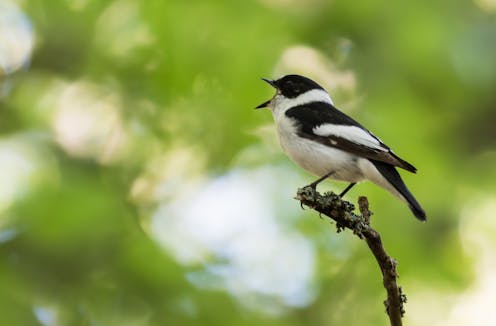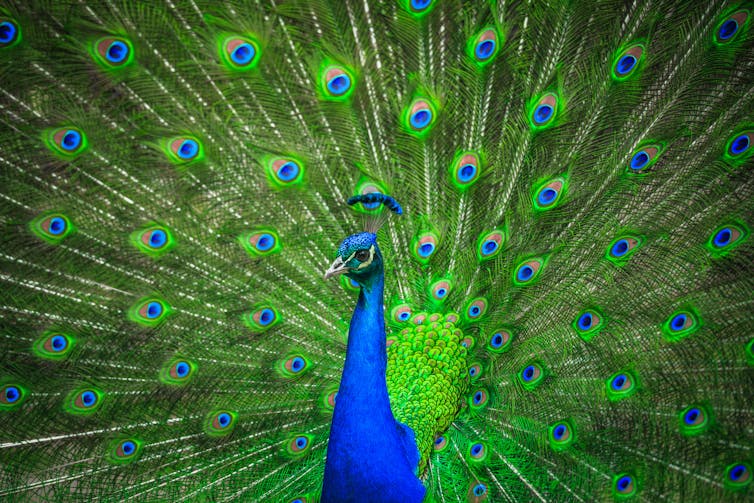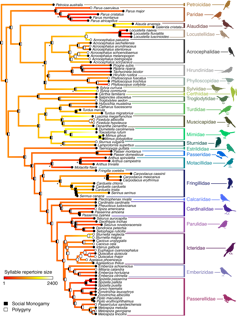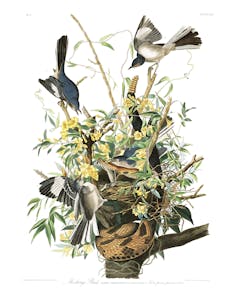Sexual selection in action: Birds that attract multiple mates change their songs more quickly
Biologists investigated whether birds that search for multiple mates would evolve ever more elaborate songs to attract them. What they found might have surprised Darwin.

How do individuals choose their mates? Why are some more successful at attracting mates than others?
These age-old questions are broadly relevant to all animals, including human beings. Darwin’s theory of natural selection offers one way to answer them. Sometimes phrased as “survival of the fittest,” the theory can also apply to mate choice, predicting that it’s beneficial to choose the mate who’s best adapted to surviving in its environment — the fastest runner, the best hunter, the farmer with the highest yields.
That’s a bit simplistic as a summary of human sexuality, of course, since people pair up in the context of complex social norms and gender roles that are uniquely human. Researchers like us do think, though, that mate choice in other animals is influenced by these kinds of perceived adaptations. It fits with scientists’ understanding of evolution: If females choose to mate with well-adapted males, their offspring might have a better chance of surviving as well. Advantageous traits wind up passed down and preserved in future generations.

But in many species, males try to attract mates by displaying characteristics that seem to be decidedly non-adaptive. These signals – such as a dazzling tail on a peacock or a beautiful tune from a songbird – were originally a big wrench thrown into Darwin’s theory of natural selection. Traits like these seem to do the opposite of making an animal more likely to survive in its environment. A flashy tail display or a showy melody is cumbersome, and it announces you to predators as well as love interests. Darwin got so upset by this inconsistency that he said “The sight of a feather in a peacock’s tail, whenever I gaze at it, makes me sick.”
Thinking about this conundrum led Darwin to another major theory: sexual selection. Instead of directly displaying adaptations, males might need to produce costly, non-adaptive signals if females prefer those features when choosing mates. For the females, these signals might indirectly communicate that a male would be a good mate because he’s able to survive and succeed — in spite of the ornament, not because of it. Under this model, the costliest traits are the most attractive.

But what if the stakes are raised, as in species that are polygynous, with males trying to attract and form bonds with multiple females? A logical next step to this theory might predict that the pressure to produce beautiful signals would skyrocket, compounding the rewards for individuals with elaborate ornaments. If the most successful males have the most extraordinary traits, an ensuing arms race over many generations could shift the population toward more extreme characteristics. This is an intuitive theory – increased competition for mates would lead to increasingly elaborate sexually selected traits – but it hasn’t been tested across the tree of life.
Do non-monogamous mating systems truly increase sexual selection in real animals? As the strength of sexual selection increases, do sexually selected characteristics become more extreme? Do tails get longer? Songs, more beautiful? As two biologists with expertise in computational methods, the evolution of behaviors and songbirds, we decided to investigate.
Building up the bird database
Evolution is as complex as life itself. New computational abilities allow researchers like us to go beyond testing whether certain traits simply tend to occur together. Instead, we can delve into the past and try to discern the path that species have traveled through history to arrive where they are today.
To test the theory that males trying to attract multiple mates would amplify sexual selection and drive the evolution of increasingly elaborate displays, we needed both a new dataset and innovative methods.
Songbirds are an excellent system with which to study this question. First, many species are socially (though not necessarily sexually) monogamous, which is otherwise exceedingly rare in the animal kingdom, but there have been numerous independent transitions to polygyny over the course of their history. That makes it easy for us to compare the songs of birds searching for a single partner to the songs of those looking for multiple mates. Songbirds also have an incredible diversity of song, from the simple tweets of the house sparrow to the elaborate cadenzas of the mockingbird.

By searching published literature and field guides, we gathered mating system data on almost 700 species and song data for over 350 species, the largest database of its kind to date. We obtained a recently published phylogeny – essentially a “family tree” that stretches all the way back to the ancestor of all birds – that covered all of avian evolutionary history. This would serve as our map through the songbird lineages.
We merged our trait data with the phylogeny to trace backwards in time, estimating how the ancestors of each group of songbirds might have sounded and behaved.
This approach is kind of like if we dropped in on a human family reunion and noticed that the vast majority of family members have blonde hair and were speaking Swedish – we’d guess that a long-gone matriarch of the family probably also had blonde hair and likely spoke Swedish. Then, we could visit another family reunion, distant relatives of the first, to find blonde people speaking mostly Norwegian. At yet another gathering, perhaps we’d see brown-haired people speaking Spanish. By doing this hundreds of times, researchers could figure out whether there was any association between hair color and language in these families’ histories.
Using similar methods with the bird family tree, we were able to test not only how mating behavior correlates with the songs of living species, but also how these behaviors affected one another over thousands and even millions of years of songbird evolutionary history. By estimating the likely behaviors of the ancestors of modern-day songbirds, we could calculate the rate of evolution of these traits, including how rates of song evolution might be influenced by mating behavior, or vice versa.

Sexual selection, but not in one direction
When we performed this deep analysis, the results surprised us. We did not find the expected relationship that songs became more elaborate in species where males were seeking multiple mates. Instead, we found an interesting evolutionary pattern: Songs seemed to be evolving faster polygynous lineages, but not in any particular direction.

Instead of these ancestral males trying to outcompete one another with more elaborate songs, songs seemed to oscillate between simple and complex like a swinging pendulum over the generations – changing quickly in the moment, but not in a consistent direction over the long term. If these polygynous species’ songs got too simple or too elaborate, they started moving back towards the middle.
These results challenge our initial broad intuitions about reproductive success and evolutionary pressures. By studying the songs of many monogamous and polygynous bird species across the evolutionary tree, we found results that stood in contrast to the prevailing wisdom: Species that attract multiple mates did not have more complex songs overall, but their songs were evolving faster. This is a new piece of evidence that may alter classical hypotheses on non-monogamy and sexual selection in evolution.
Our work shows that when scientists study sexual selection in the future, we need to think not only about the magnitude of the traits being studied, but also how fast they change.
Nicole Creanza has received funding from Vanderbilt University, the Ruth Landes Memorial Research Fund, the John Templeton Foundation, and the Stanford Center for Computational, Evolutionary, and Human Genomics.
Kate Snyder receives funding from Vanderbilt University Department of Biological Sciences and the Vanderbilt University Graduate School.
Read These Next
West Coast levee failures show growing risks from America’s aging flood defenses
Levees protect more than 7 million buildings in the US today, yet they got a D-plus grade in 2025. A…
LA fires showed how much neighborliness matters for wildfire safety – schools can do much more to te
Managing fire risk is about more than regulations and rules. It’s also about caring for neighbors…
Has the Fed fixed the economy yet? And other burning economic questions for 2026
As 2026 begins, uncertainty is at the top of everyone’s mind.






